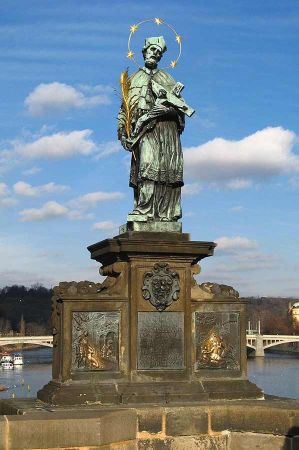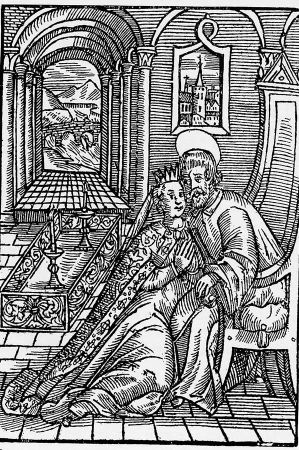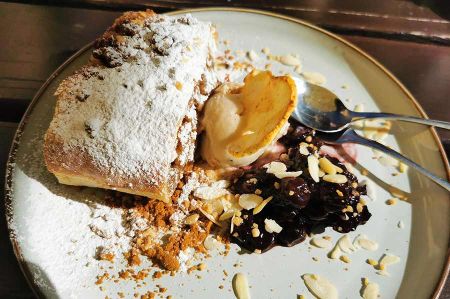Nepomuk – not just a well-known dragon that no one wants
- Written by Portal Editor
Who doesn't know Michael Ende's tragic-funny story about the little green dragon Nepomuk, who actually has everything a dragon needs for happiness: sharp teeth, shimmering scales and his own fire-breathing volcano.
But because his mother was a hippopotamus, the purebred dragons exclude him and no one is afraid of him. Can Jim Knopf and Lukas, the locomotive driver, help him?
In any case, the story of Nepomuk was immediately in our minds when we came across the small town of Nepomuk on the way to the South Bohemian Aleš Gallery. As is so often the case, our interest in exploring was immediately aroused, because how did one come up with this name, which we previously thought was more of a first name. We should quickly realize that this male first name we know actually goes back to John of Nepomuk from Nepomuk, this city in Bohemia.
Ebrach Monastery founds Cistercian Monastery Nepomuk
Several villages soon grew up around the Cistercian monastery Nepomuk in Klášter, founded in 1144 from the Ebrach monastery, including Pomuk.
Today's Nepomuk had legal residence since 1250 and market rights from 1254. The place, like the neighbouring village of Přesanice, became rich in the 13th and 14th centuries through gold soap and silver mining. In 1384 Přesanice and Nepomuk united. In 1413 the place was granted city rights by Wenceslaus the Lazy.
In April 1420 the town and monastery were burned down by Jan Žižka's troops. While the monastery remained devastated, the city was rebuilt by German colonists.
Saint Nepomuk – better known as John of Nepomuk
Johannes Nepomuk was born as Johannes Welflin in Pomuk (today's Nepomuk) in West Bohemia and probably came from a German-Bohemian family. Pomuk belonged to the manor of the Cistercian monastery of the same name from Ebrach, to which the founding of the monastery in the mission area of Bohemia goes back. He is first mentioned as a cleric in 1370. When he was ordained a priest in 1380, he took on the title of altar priest with Saints Erhard and Ottilie in St. Vitus Church and received the well-paid pastor's position at Gallus Church.
During the Great Western Schism, there were power-political disputes between King Wenceslaus IV and his former chancellor, Archbishop Johannes Jenstein of Prague. It was about the demarcation of the secular and ecclesiastical spheres of power in the former mission area of Bohemia, especially the transfer of high church offices and privileges and the appointment of bishops. In the year-long dispute, a favourite of King Wenceslas was excommunicated in 1392 in a trial presided over by John of Nepomuk as the archbishop's representative.
 As the confrontation continued, John of Pomuk was arrested and tortured along with other archbishop officials, while the archbishop himself managed to escape. As the highest-ranking, but due to his origins, the least important bishop's representative, John of Nepomuk was ultimately thrown from the Charles Bridge into the Vltava and drowned. Drowning was the usual death penalty for clergy in the Middle Ages.
As the confrontation continued, John of Pomuk was arrested and tortured along with other archbishop officials, while the archbishop himself managed to escape. As the highest-ranking, but due to his origins, the least important bishop's representative, John of Nepomuk was ultimately thrown from the Charles Bridge into the Vltava and drowned. Drowning was the usual death penalty for clergy in the Middle Ages.
According to legend, the corpse of the man floating in the water was surrounded by five flames or “brightly shining miraculous signs”, which is why Johannes Nepomuk is often depicted with five stars around his head. According to another legend, the Vltava dried up and the dead man's body was found this way. In fact, the body that washed up on the shore was first buried in the Church of the Holy Cross. In 1396 the archbishop's successor, his nephew Olbram von Škvorec, had him transferred to St. Vitus Cathedral in Prague.
Legends and myths lead to canonization
 According to the legend that led to the later canonization of John Nepomuk, his dispute with the king did not arise from the ecclesiastical political conflict, but from his refusal to break the secrecy of confession. Accordingly, the priest did not want to reveal to the king what his wife, whom Wenceslaus suspected of infidelity, had confided to him. That's why Wenzel tortured him and then had him fall from Prague's Charles Bridge into the water. This version of the martyrdom story was documented for the first time in the Liber Augustalis (“Imperial Chronicle”) by the Viennese chronicler Thomas Ebendorfer, written around 1450, who attests to its spread in 1433.
According to the legend that led to the later canonization of John Nepomuk, his dispute with the king did not arise from the ecclesiastical political conflict, but from his refusal to break the secrecy of confession. Accordingly, the priest did not want to reveal to the king what his wife, whom Wenceslaus suspected of infidelity, had confided to him. That's why Wenzel tortured him and then had him fall from Prague's Charles Bridge into the water. This version of the martyrdom story was documented for the first time in the Liber Augustalis (“Imperial Chronicle”) by the Viennese chronicler Thomas Ebendorfer, written around 1450, who attests to its spread in 1433.
The veneration of Jan Nepomuk in Bohemia increased in the 16th century, but only reached its peak with the re-Catholicization efforts of the 17th century. It was also staged as a counter-cult in order to displace the veneration of the Czech reformer Jan Hus, who had also worked as a priest and theologian in Prague and almost at the same time as Nepomuk and was actually the confessor of Queen Sophie of Bohemia, the second wife of King Wenceslas IV.
Short tour of the city of Nepomuk
We parked our vehicle at Pschesanitzer Platz and set off on a tour of the town, first coming across the Gothic St. James Church, which was built between 1290 and 1295.
The three-aisled hall church measures 16 by 18 m inside.
The family crypt of the Counts of Sternberg is located in the church.
The presbytery of the church was decorated with red marble. In 1780, a baroque church tower was added to replace the dilapidated bell tower on the sacristy.
The arch deanery, located next to the church, was built in 1678 in place of a previous wooden building.
It was built in 1748 according to plans by Kilian Ignaz Dientzenhofer and received its current appearance after a renovation between 1939 and 1945.
The Church of St. John of Nepomuk stands on the site of a previous building built between 1643 and 1660.
The church, originally dedicated to John the Baptist, was dedicated to the new patron saint in 1729 on the occasion of his canonization and was demolished in 1734.
Today's baroque church was built in 1736 under the direction of Kilian Ignaz Dientzenhofer.
 The house “Zur Böhmischen Linde” on Pschesanitzer Platz, built between 1360 and 1370, later served as a town hall and inn, which we also appreciated while enjoying a small snack on the terrace: apple strudel with beer ice cream and cream. We recommend.
The house “Zur Böhmischen Linde” on Pschesanitzer Platz, built between 1360 and 1370, later served as a town hall and inn, which we also appreciated while enjoying a small snack on the terrace: apple strudel with beer ice cream and cream. We recommend.
By the way, and also for hikers and pilgrims: the town of Nepomuk is on the Way of St. James to Santiago de Compostella.
Please read as well:
Beginning 70s - Emerson, Lake and Palmer and HR Giger
HR Giger - Invitation to the exhibition “Metamorphoses”
-
 Nepomuk at Jacobspath to Santiago de Compostella
Nepomuk at Jacobspath to Santiago de Compostella
Nepomuk at Jacobspath to Santiago de Compostella
Nepomuk at Jacobspath to Santiago de Compostella
-
 Nepomuk at Jacobspath to Santiago de Compostella
Nepomuk at Jacobspath to Santiago de Compostella
Nepomuk at Jacobspath to Santiago de Compostella
Nepomuk at Jacobspath to Santiago de Compostella
-
 Nepomuk at Jacobspath to Santiago de Compostella
Nepomuk at Jacobspath to Santiago de Compostella
Nepomuk at Jacobspath to Santiago de Compostella
Nepomuk at Jacobspath to Santiago de Compostella
-
 Nepomuk at Jacobspath to Santiago de Compostella
Nepomuk at Jacobspath to Santiago de Compostella
Nepomuk at Jacobspath to Santiago de Compostella
Nepomuk at Jacobspath to Santiago de Compostella
-
 Nepomuk at Jacobspath to Santiago de Compostella
Nepomuk at Jacobspath to Santiago de Compostella
Nepomuk at Jacobspath to Santiago de Compostella
Nepomuk at Jacobspath to Santiago de Compostella
-
 Nepomuk at Jacobspath to Santiago de Compostella
Nepomuk at Jacobspath to Santiago de Compostella
Nepomuk at Jacobspath to Santiago de Compostella
Nepomuk at Jacobspath to Santiago de Compostella
-
 Nepomuk at Jacobspath to Santiago de Compostella
Nepomuk at Jacobspath to Santiago de Compostella
Nepomuk at Jacobspath to Santiago de Compostella
Nepomuk at Jacobspath to Santiago de Compostella
-
 Nepomuk at Jacobspath to Santiago de Compostella
Nepomuk at Jacobspath to Santiago de Compostella
Nepomuk at Jacobspath to Santiago de Compostella
Nepomuk at Jacobspath to Santiago de Compostella
-
 Nepomuk at Jacobspath to Santiago de Compostella
Nepomuk at Jacobspath to Santiago de Compostella
Nepomuk at Jacobspath to Santiago de Compostella
Nepomuk at Jacobspath to Santiago de Compostella
-
 Nepomuk at Jacobspath to Santiago de Compostella
Nepomuk at Jacobspath to Santiago de Compostella
Nepomuk at Jacobspath to Santiago de Compostella
Nepomuk at Jacobspath to Santiago de Compostella
-
 Nepomuk at Jacobspath to Santiago de Compostella
Nepomuk at Jacobspath to Santiago de Compostella
Nepomuk at Jacobspath to Santiago de Compostella
Nepomuk at Jacobspath to Santiago de Compostella
-
 Nepomuk at Jacobspath to Santiago de Compostella
Nepomuk at Jacobspath to Santiago de Compostella
Nepomuk at Jacobspath to Santiago de Compostella
Nepomuk at Jacobspath to Santiago de Compostella
-
 Nepomuk at Jacobspath to Santiago de Compostella
Nepomuk at Jacobspath to Santiago de Compostella
Nepomuk at Jacobspath to Santiago de Compostella
Nepomuk at Jacobspath to Santiago de Compostella
-
 Nepomuk at Jacobspath to Santiago de Compostella
Nepomuk at Jacobspath to Santiago de Compostella
Nepomuk at Jacobspath to Santiago de Compostella
Nepomuk at Jacobspath to Santiago de Compostella
-
 Nepomuk at Jacobspath to Santiago de Compostella
Nepomuk at Jacobspath to Santiago de Compostella
Nepomuk at Jacobspath to Santiago de Compostella
Nepomuk at Jacobspath to Santiago de Compostella
-
 Nepomuk at Jacobspath to Santiago de Compostella
Nepomuk at Jacobspath to Santiago de Compostella
Nepomuk at Jacobspath to Santiago de Compostella
Nepomuk at Jacobspath to Santiago de Compostella
-
 Nepomuk at Jacobspath to Santiago de Compostella
Nepomuk at Jacobspath to Santiago de Compostella
Nepomuk at Jacobspath to Santiago de Compostella
Nepomuk at Jacobspath to Santiago de Compostella
-
 Nepomuk at Jacobspath to Santiago de Compostella
Nepomuk at Jacobspath to Santiago de Compostella
Nepomuk at Jacobspath to Santiago de Compostella
Nepomuk at Jacobspath to Santiago de Compostella
-
 Nepomuk at Jacobspath to Santiago de Compostella
Nepomuk at Jacobspath to Santiago de Compostella
Nepomuk at Jacobspath to Santiago de Compostella
Nepomuk at Jacobspath to Santiago de Compostella
-
 Nepomuk at Jacobspath to Santiago de Compostella
Nepomuk at Jacobspath to Santiago de Compostella
Nepomuk at Jacobspath to Santiago de Compostella
Nepomuk at Jacobspath to Santiago de Compostella
-
 Nepomuk at Jacobspath to Santiago de Compostella
Nepomuk at Jacobspath to Santiago de Compostella
Nepomuk at Jacobspath to Santiago de Compostella
Nepomuk at Jacobspath to Santiago de Compostella
https://www.alaturka.info/en/czech-republic/cheb/6313-nepomuk-not-just-a-well-known-dragon-that-no-one-wants#sigProId16efb419ae
